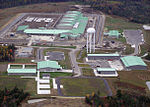Success, New Hampshire
Berlin, New Hampshire micropolitan areaTownships in Coös County, New HampshireTownships in New HampshireUse mdy dates from July 2023

Success is an unincorporated township in Coös County, New Hampshire, United States. It is located directly to the east of the city of Berlin, and borders on the state of Maine. Success is part of the Berlin, NH–VT Micropolitan Statistical Area. As of the 2020 census, the township had a population of 4. There are seasonal homes, cabins, and cottages mainly located around Success Pond, which give the township an additional small seasonal population. As of 2005, one of the larger landowners in Success is the Androscoggin Valley Regional Refuse Disposal District.
Excerpt from the Wikipedia article Success, New Hampshire (License: CC BY-SA 3.0, Authors, Images).Success, New Hampshire
Geographical coordinates (GPS) Address External links Nearby Places Show on map
Geographical coordinates (GPS)
| Latitude | Longitude |
|---|---|
| N 44.514444444444 ° | E -71.073888888889 ° |
Address
Success
(Success)
New Hampshire, United States
Open on Google Maps







